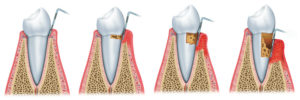Check Ups & Teeth Cleaning
A great smile is dependent on healthy gums and clean teeth. Regular dental cleanings and exams will help you maintain your dental health for years. At your regular checkup the hygienist will perform a thorough cleaning of your teeth, visual assessment of your mouth and take any diagnostic x-rays that are necessary. The hygienist will review your home care with you and discuss what you are doing well and any areas that could be improved upon. Dr. Harkins will examine your teeth, review x-rays that were taken and discuss with you any concerns that he sees or that you may have. You are part of our team in taking care of your health.
Cleanings are very important to your oral health. Three quarters of the population are at risk for gum disease. Gingivitis is the beginning stage of gum disease and it is usually silent causing no real pain or issue for the person. Occasionally one may notice a little bleeding while brushing. The plaque and calculus (tartar) is irritating the tissues causing tiny ulcerations which lead to the bleeding. The body’s immune response is beginning to kick in. The gum tissue begins to retreat from the irritants. Recession of the gums can begin to occur. This is dangerous because if the gum tissue dips below where the enamel ends; the root surface of your tooth is exposed making it more vulnerable to sensitivity and decay. If plaque and calculus continue to grow a periodontal pocket can form. A periodontal pocket can harbor more bacteria and the disease process can continue eventually becoming periodontal disease. Bone loss of the bone that supports your teeth will begin in these stages of the disease. Periodontal disease is one of the leading causes of tooth loss. Please do not underestimate the importance of regular routine care in which the plaque and calculus will be removed and any problem areas can be identified.

Progression of Gingivitis and Periodontal Disease
The above picture shows the teeth in different stages of periodontal health. The instrument you see is a little measuring tool that lets the hygienist see where the gum tissue attaches to the tooth and if there is inflammation from tartar or plaque present. If there is a lot of tartar present, there will be attachment loss as shown in the last picture.



